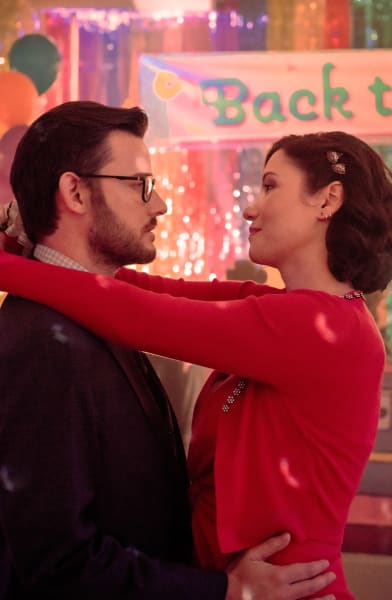
Nowadays, it seems like a quaint notion that a television series might stay on the air long enough to run out of ideas.
But almost fifty years ago, even a successful show like Happy Days wasn’t immune to using outlandish stunts to bolster ratings.
And thank goodness for that, or we might all have been deprived of the cultural touchstone that is Fonzie jumping the shark.

Fonzie Jumps the Shark (And Enters History)
The phrase “jump the shark” has become shorthand for the moment when a television show loses its creative way and begins a downward spiral in quality and popularity.

However, when the actual shark jump happened in the “Hollywood: Part 3” episode of the show’s fifth season, Happy Days hit number one in the Nielsen ratings.
The series aired for another six well-received seasons and even had successful spinoffs in the sitcoms Laverne & Shirley and Mork & Mindy.
Fonzie’s leather jacket-clad shark jump was definitely an odd narrative choice, but it didn’t push the series off a creative cliff toward cancellation.
(Also, am I the only one who never knew that Henry Winkler used to be a waterskiing instructor??)
Back when the average TV series had 22-episode seasons and aired for several years, a little creative fatigue was understandable.
But even in this new century, with its shortened streaming landscape, television is still remarkably good at ruining great shows.

TV hasn’t forgotten its old standbys like wedging a baby or kid into an established cast (Rachel’s pregnancy on Friends; Luke’s surprise tween daughter April on Gilmore Girls; Scrappy Doo full-stop).
Or suggesting that everything in a show was just a dream (St. Elsewhere, Newheart, Roseanne).
13 Tired Tropes TV Can Turn On Their Heads
A more recent addition is when a show features a huge time jump (Lost, New Girl) or total concept reframe (the introduction of Dawn Summers on Buffy Season 5, NEVER to be forgiven).
These pivots might seem senseless, but they are often in reaction to sudden changes in the cast or behind-the-scenes talent.
However, that doesn’t make them any less maddening (still looking at you, Dawn!).

The Rise of the Gradual Shark Jump
Modern-day “shark jumps” tend to be less of a singular event and more of an extended three-point turn.
Audiences roughly remember when Game of Thrones started to decline but might argue over which moment caused them to leave the show.
Then there’s the truly epic shark jump taken by How I Met Your Mother, where an entire season focused on the events of one weekend.
Now that streaming series usually feature just six to ten episodes per season, it seems they wouldn’t have enough time to run out of ideas.
Yet we still see those baffling moments when shows go off the rails.

Jumping the Shark In a Bid For Survival
One reason is that while TV seasons might be shorter and allow for more quality control, the shows themselves have fewer guarantees of renewal than they did even a decade ago.
Ratings have always determined which shows stay on the air, of course.
However, a new lack of transparency in how audience numbers are calculated, plus the frequent sales and mergers of entertainment companies, has had a negative creative impact on shows in several ways.
TV Ratings Winners of the 2024 Season So Far
An example of this is when Amazon Prime Video recently inserted ads into its default paid tier, and concerns arose about the future of its ad-supported Freevee channel.
Assurances were made that Freevee was not going anywhere, but the same can’t be said for its original content when creator Shea Serrano’s Primo, a well-received show that enjoyed a popular first season, was canceled this week.

Netflix has become infamous for canceling shows after two seasons, which causes viewers to hesitate before watching them.
The constant threat of cancellation might also lead shows to frontload their seasons with a barrage of new plotlines and characters designed to grab the audience’s interest and raise the odds of renewal.
This happened with the second season of Hallmark Channel’s The Way Home, a moody yet charming show whose first season used supernatural elements to unspool a painful family mystery.
The first season’s tight focus on a small group of characters made us highly invested in their search for answers to a decades-old event that changed all of their lives.

The show dealt honestly with grief and regret and didn’t shy away from having the characters learn to live with the consequences of their actions.
All that went out the window (or through the pond) in Season 2.
The show exchanged one heartfelt mystery for about ten new subplots, then spent most of its time on the least interesting one. It also changed the rules of its world to reverse the most important aspects of the first season.
The Way Home Fans Are Split Over the Season 2 Finale: Did the Show Jump the Shark or Is the Best Yet to Come?
Plus, several new minor characters took time away from the core main characters we’d already come to care about and left little opportunity for their continued growth.
This throw-everything-at-the-wall approach apparently worked since the show is returning for a third season.

The Challenges of Telling a Compelling Story In Uncertain Times
The flip side of a show suddenly being canceled is when it is unexpectedly renewed.
If each season is treated like it could be the last, it is wise to tie up loose ends and avoid cliffhangers (which is something I really wish So Help Me Todd would have done — OMG, you can’t leave us hanging like that!).
However, too much narrative closure can cause a creative scramble if a series renewal means starting the next season from virtual scratch.
This can trip up newer shows and mar the endings of longer-running ones.
Scrubs and Elementary were victims of surprise renewals after effectively wrapping up their long and successful runs.

Scrubs shifted its format to focus on a new cast for its final season, while Elementary fared a bit better by utilizing a time jump (mostly to explain Lucy Liu’s blonde hair).
However, these examples are corporate miscommunications rather than jumps that even the sharks could see coming.
Many more shows would have been better off ending when their stars or creators left, sparing us their awful final seasons.
The Office suffered in quality after Steve Carell’s departure, Gilmore Girls never should have attempted a post-Amy Sherman-Palladino season, and Suits *definitely* should have ended after losing both Meghan Markle AND Patrick J. Adams at the end of Season 7.
Suits actually brings us full circle to the intersection of TV season length, audience numbers, and attention-getting stunts.

A Shift In Preferences?
Much like the now-classic show Friends, Suits has gained a surprising new generation of fans through its availability on Netflix.
This popularity has ignited debate on What Audiences Want, with a decided bent toward how longer seasons allow for a more relaxed pace of character and plot development that fosters audience engagement and loyalty.
Suits, Ted Lasso, and the Rise of Comfort TV: Is the Desire For Easy Viewing Creating a Barren Streaming Landscape?
A decade’s worth of 22-episode seasons also provides a gold mine of comfort viewing for original and new audiences.
Of course, instead of overhauling their current two-season original series development model, Netflix went for a Suits reboot.
To paraphrase a character in author Jordan Harper’s Hollywood neo-noir novel Everybody Knows: “Somebody somewhere catches lightning in a bottle — and all over town people run out and they buy bottles.”

One can argue that the old 22-episode season model is untenable in today’s world of tight entertainment budgets and short audience attention spans.
Or, one can point out that most of our now-classic TV series were not hits right out of the gate, and a little breathing room for show creators might exponentially benefit both viewing audiences and production companies.
There is a rich middle ground to be mined in terms of nurturing shows that, given time, could become part of our culture’s history.
Viewing audiences seem willing to strap in for long-running shows they can follow and enjoy over time; why can’t production companies do the same?
What are your favorite jump-the-shark moments? Let us know in the comments!
Paullette Gaudet is a staff writer for TV Fanatic. You can follow her on X.






















![Burna Boy – City Boys [Official Music Video] Burna Boy – City Boys [Official Music Video]](https://i.ytimg.com/vi/hLDQ88vAhIs/maxresdefault.jpg)
